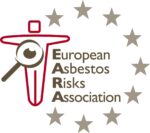After the successful experience in Udine on February 17th, 2012, EARA has chosen the city of Pordenone to organize the third edition of the biennial convention ‘Asbestos, state of the art ‘. The main theme of the conference was to stress on the best actions to promote primary prevention or remediation of asbestos in polluted sites (see the problem of Cellina-Meduna rivers bed, the roofs of several abandoned industrial buildings, and more) with contributions by leading experts, involving representatives of the local authorities concerned to apply best practices for the clean-up of public and private sites .
The conference, held from 9 to 12 am on Friday, February 21st, 2014 at the prestigious council chamber of the Province of Pordenone in Largo S. Giorgio 12, saw the presence (thanks to the extraordinary work of contacts with school headmasters lead by our councilor Gaspardo) of nearly eighty students from two senior high schools of the city, the ITS S. Pertini and I.T.S. Innovation ‘JFK’, accompanied by their teachers. For Region Friuli Venezia Giulia, two were the counselors attending: Chiara Da Giau and Renata Bagatin (PD), and only one mayor, Stefano Turchet (Porcìa).
Stefano Zannier, assessor for Environmental Protection of the Province of Pordenone, who brought greetings from the administration, said that the asbestos issue has been overlooked for too long, and it is sure that the speakers will share concrete proposals and know which is the real problem, that concerns the health of us all. The numbers of deaths are frightening, although there is a different sensibility than in the past years, so everyone must give his own contribution for a solution. With disappointment, Zannier verified that, apart from the mayor of Porcia, no other First citizen of the province was present.
Paolo Tomatis, EARAs president, thanked the provincial administration of President Ciriani for cooperation, stressing the importance of making the younger generation aware of the asbestos problem, which is meant to frame not only in a regional perspective but also at European level and across borders, as in neighboring Slovenia and Croatia, which still have big environmental and health problems with asbestos, and for this reason they are the two countries which the association is following closely, since on January 29th an EARA delegation was received for a hearing before the Joint Commission Environment / Health at the Sabor (Parliament) of Croatia. The best – according to Tomatis would be to integrate inertization processes with the remediation of polluted sites, provided that both are made ??in full compliance with the rules.
Following the greetings to the audience from Zannier and Tomatis, the conference chairman, Paolo Verardo, of the Provincial ecology and industry waste management services of Pordenone, presented the two first speakers: Eng. Renzo Simoni (Department for Safety and Prevention in Work Environments, ASS n. 1 – Trieste), who talked about Asbestos: uses, risks and future possibilities. A short story, and Giulio Sossi (Geo -SAT Progetti srl, Trieste), on The dumpyard for non-hazardous waste and disposal of construction materials containing asbestos in Cross Vial, City of Porcia.
In the second part of the conference, other two speakers were called by Mr. Verardo: Glauco Spanghero (Department of Technical and Scientific High Risks, ARPA FVG – Palmanova), who talked about Asbestos in Friuli Venezia Giulia. The mapping techniques of ARPA FVG on GIS and geospatial processing with its future development, and afterwards, Claudia L. D’Alessandro (Complex Structure for Work Environments, Department of Prevention, Health Service Company no. 6 ‘Friuli Occidentale’), about The health repercussions of asbestos problem in the province of Pordenone.
At the end of the conference, the moderator gathered all four speakers at the table and started an interesting debate involving the public, especially students: some of them took the opportunity to ask several questions, especially on modern techniques of neutralization described by Simoni, with related systems, costs and reuse of old material, and its transformation into new products. One student then turned to president Tomatis some questions about European legislation on asbestos: the ones in Italy and Poland, said Tomatis, are two of the most advanced in Europe. In another specific question about who is the main health authority in the municipalities, Spanghero answerd by stating that the mayors are the leading authorities in this field. They decide if to intervene, and – when necessary – how to. Talking about monitoring, the probe for measurement – explained Spanghero – is not of big dimensions, but to make it fly for aerial shots and monitor the underlying earth, costs a lot of money. According to Simoni, we could just use infrared.
The students, most of whom were very interested in the subject (for the vast majority of them, it was totally new), asked for copies of the EARA-Federsanità ANCI Conference Report in Udine (2012) and of our magazine EARAnews, which went sold out in less than one minute, and this never happened before. A sign that the event, organized in a few weeks, has obtained a good success, thanks to speakers and moderator, all of high level.
